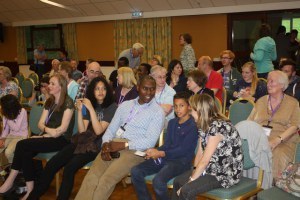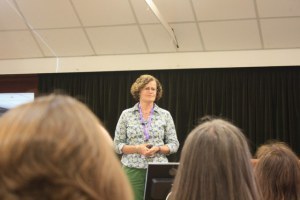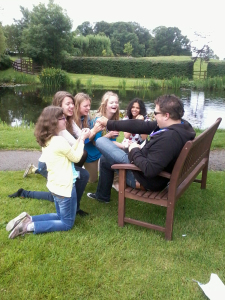S.C. Skillman's Blog, page 64
August 26, 2013
Guys Cliffe House, Romantic Ruin in a Dreamlike State, Awaiting New Life
What could be more poignant than a formerly grand mansion, standing on a cliff, now partially demolished, abandoned and desolate?
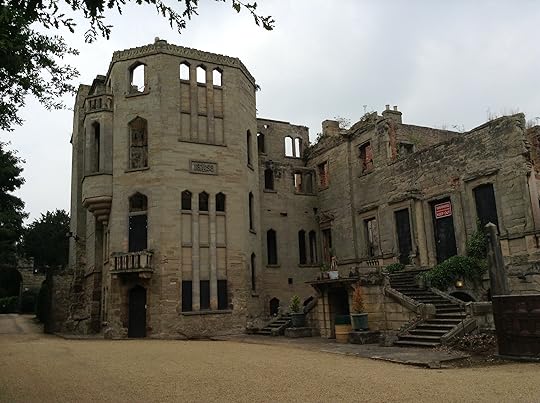
Guy’s Cliffe House 25 Aug 2013 (photo credit: Jamie Robinson)
Gaping staircases you cannot climb; stone balconies you long to stand on to gaze at the view; empty windows you feel sure a shadowy figure should flit past.
Just such a gaunt mansion is Guy’s Cliffe House, our local romantic ruin, perched atop a cliff above the River Avon, catching the imagination of all who pass by on the other side of the river.
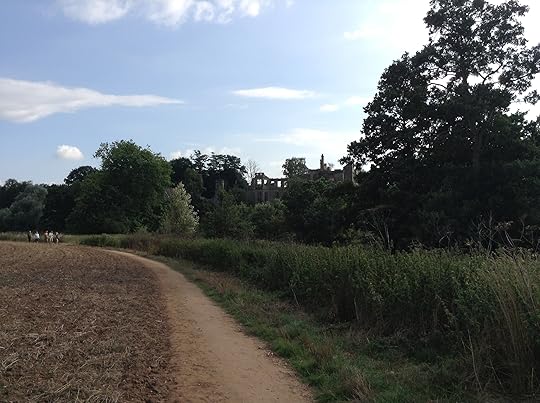
Guy’s Cliffe House as seen from the footpath on the other side of the river Avon (photo credit Jamie Robinson)
Gothic stone tracery, an ornate balcony, evidence of a flambuoyant builder, remain to tantalize you.
For one of those who occupied the house embellished it with Roman, classical, mediaeval and Gothic elements.
Guy’s Cliffe House so caught my own imagination during the past few years that I occasionally wished that, if I was hugely wealthy, I could pay for it to be restored to its former glory.
In reality, I’d like it to be made safe for people to enter and explore, and for new timber staircases and walkways to be constructed, so we could climb to those balconies and gaze at the view.
And I’d like all the original formal gardens to be restored so people can wander around in them and enjoy the romantic setting.
I feel that Guy’s Cliffe is a poignant illustration of what happens when wealthy property owners do not successfully pass on their property to an equally rich and prudent and competent heir.
One developer/house-breaker deliberately demolished part of the Guy’s Cliffe House, then all the contents were auctioned off, and and accidental fire and neglect did the rest.
We all find it difficult to understand how such a grand property gets damaged, ransacked and neglected like that.
8 foot tall bamboo now crowds close to the cave in the cliff, where Guy of Warwick, in the tenth century, returned from the Holy Land and mysteriously chose to live for two years, rather than reuniting with his wife and child in the house above.
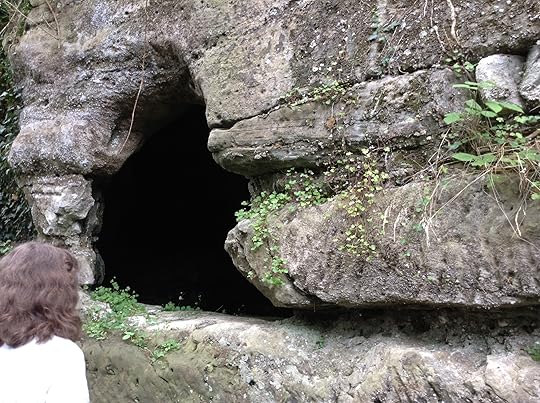
The cave where Guy of Warwick lived for 2 years (photo credit: Jamie Robinson)

The chapel of Mary Magdalene with Guy’s Cliffe House behind (photo credit: Jamie Robinson)
And next to the house, the lovely chapel of Mary Magdalene contains Guy’s figure in stone, representing him to be 8 ft high.
The formal gardens have vanished, overgrown by tall trees and shrubs and bamboo.
tall bamboo crowds close to Guy’s Cliff,in place of the earlier formal gardens
It’s like another world – untouched, just left as it is.
So many windows. You feel somebody should appear in them.
We couldn’t fail to wonder and imagine as we took the guided tour around the house and grounds on 25 August 2013, guided by our host Adrian, with an excellent, fluent and richly informative talk.
If you’re in the area of Warwick then don’t forget to book a guided tour round Guy’s Cliffe after you’ve visited Warwick Castle!
Filed under: architecture, British, buildings, culture, dreams and dreaming, English countryside, history, inspiration, life, places of inspiration, SC Skillman, thoughts Tagged: another world, dreamlike, Guy's Cliffe House, imagination, mysterious, new life, poignant, romantic ruin, romantic setting, SC Skillman author, Warwickshire, wonder and imagine


August 20, 2013
Sacred Spaces in the English Landscape and Places of Inspiration: Stonehenge and Salisbury Cathedral

Stonehenge 17 Aug 2013 (photo credit Jamie Robinson)
Throughout the English landscape there’s evidence that our ancestors shaped the land, to conform to their own mythological landscape.
I’ve written before about sacred spaces. In that article, I looked at some renowned locations in England where people have felt they’re in touch with something bigger than themselves – a sense of the numinous.
All of these places work symbolically or metaphorically to express a place where we may be or a situation we may encounter in this life, that we recognise from our own experience.
And one such renowned location is Stonehenge – which I visited a few days ago with family members.
To walk slowly and attentively around Stonehenge, using the audio guide provided by English Heritage, is to experience something numinous, much bigger than ourselves.
The stones arrived here some time just before 2500 BC, to begin transforming the previously existing simple enclosure to something much different. And as we considered the huge effort that our ancestors put into moving the stones 19 miles from the Marlborough Downs in north Wiltshire, and 150 miles from the Preseli Hills in Wales, to this location, in order to construct this massive circle, we were drawn in to the wonder and the mystery.
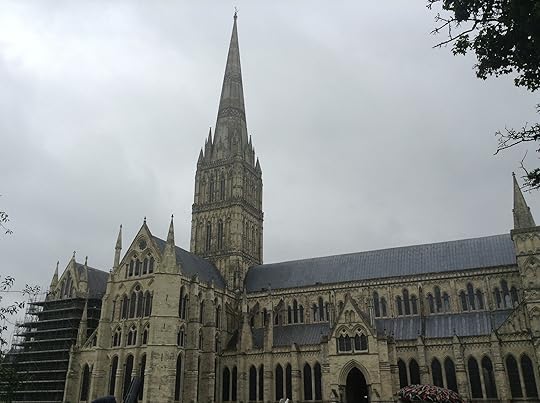
Salisbury Cathedral. Its spire is the tallest cathedral spire in England (photo credit Jamie Robinson)
Those who accept the theory of ley lines know that Stonehenge stands on the Old Sarum Ley which is aligned with Salisbury Cathedral , among other sacred places.
As the English Heritage guidebook points out, Stonehenge can perhaps be seen as the prehistoric equivalent of a great cathedral like that at nearby Salisbury, built for worship and as a place where believers could come to find healing and hope and where important people can be buried.
Salisbury Cathedral, described as Britain’s finest 13th Century Cathedral, is another inspirational place.
From its glorious chancel roof 
The chancel roof of Salisbury Cathedral (photo credit Jamie Robinson)
to the stunningly beautiful lapis lazuli of the Prisoners of Conscience windows,
this is a place to move and uplift and fill you with awe.
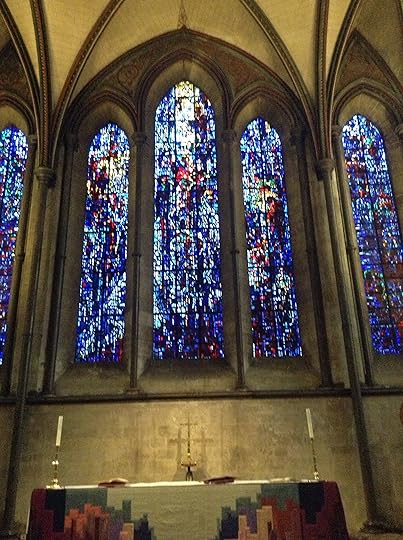
Prisoners of Conscience window in Salisbury Cathedral (designed by Gabriel Loire; dedicated to prisoners of conscience throughout the world. (photo credit Jamie Robinson)
Here, the hearts and minds of all those who enter, for worship or just to visit, may be lifted up to a bigger and clearer understanding of God.
Or, perhaps, they may receive fresh glimpses of eternity, in much the same way, perhaps, as the hearts and minds of those who built and used Stonehenge over the course of 1,400 years.
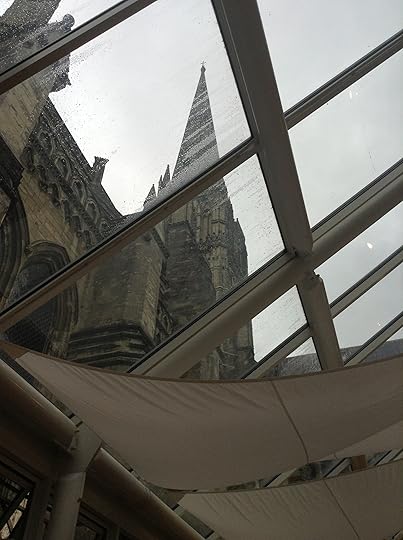
Another view of the spire of Salisbury Cathedral (photo credit: Jamie Robinson)
Filed under: architecture, British landscape, buildings, culture, design, English countryside, faith, history, inspiration, life, musings, mystery romance, Mystical Circles, mythology, places I love, places of inspiration, spirituality, thoughts, travel, UK Tagged: glimpses of eternity, God, in this life, inspiration, inspirational, life, mythological, numinous, sacred, sacred spaces, Salisbury Cathedral, SC Skillman, Stonehenge


August 6, 2013
Book Review: ”Religion for Atheists’ by Alain de Botton
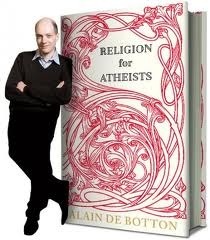
Religion for Atheists by Alain de Botton
Religion for Atheists: A Non-Believer’s Guide to the Uses of Religion
came into my hands the other day, recommended by a friend. The book was published by Penguin in 2012.
I’ve now finished the book and given it a rating on Goodreads & Amazon of 3 out of 5 stars
Review:
Initially, this book held great possibilities for me. It seemed an intriguing thesis.
De Botton, an atheist, acknowledges that although he has no supernatural beliefs, there are many good things in religious practice – and he cites the examples of Christianity, Judaism and Buddhism – which would be of benefit to secular society. So he proposes that the secular world should take all that’s good in religious practice, and apply it in secular institutions – minus the supernatural beliefs.
“Those of us who hold no religious or supernatural beliefs still require regular rituals and encounters with concepts such as friendship, community, gratitude and transcendence.” All tasks should be done through relationship. (This is a quote from a Christian source, Annie Naish, who is a missioner with the Lee Abbey community.) And De Botton has taken this on board well, as he sets forth his ideas.
I like books of philosophy which ruminate about our society and our presumptions and our contemporary culture. The author’s premise seemed to enable him to come from a fresh perspective, free of ‘attitude’, of the kind we associate with the over-exposed Richard Dawkins.
But ultimately I felt that de Botton’s ideas (which he illustrates in various photoshopped pictures throughout his book) would work best on the walls of the Hayward Gallery as part of their exhibition: “An Alternative Guide to the Universe.”
I will however admit that his book works well as a stimulant for discussion. And I agree that many people who have no ‘supernatural beliefs’ would appreciate and benefit from numerous good things about religious practice and customs. And it should not be necessary to hold those beliefs, in order to benefit from all those good things.
I was amused by the author’s argument about using culture in place of scripture; I myself know very well how, for instance, the operas of Wagner can be “secular society’s new sacrament”, and how the profound messages to be found in George Eliot’s “Middlemarch” can (to quote de Botton) “take up the responsibilities previously handled by the Psalms.”
On page 113 he says “Christianity concerns itself…with the inner confused side of us.” I accept that this in many cases is true.
Then on pg 122 he says that his university of the future would provide classes in:
1) reconsidering work,
2) improving relationships wth children
3) reconnecting with nature
and
4) facing illness.
His imaginary university would establish a Department for Relationships, an Institute of Dying, and a Centre for Self-Knowledge.
Although I was amused by these suggestions, I could see that in reality they would not work at all.
De Botton makes several observations about the human condition, of which this is an example: on pg 192 he remarks how many go through life “dynamiting their chances of success through idiocy and impatience”. I can relate to much of what he says about the default setting of human life, but I don’t agree with his overarching philosophical premise.
One of his points is that religions have fully recognised how sad life is – unlike the false hope engendered by the secular world – and have evolved systems to deal with it. This is a good point and yet, for me, his thesis demands further questions: “But what then…?” and “Why should…?”
This is a book which carried me through for a long way… and then I got to the final third of the book and realised there’s a giant hole at the centre of the author’s argument, and it all ends on a down-note.
Beyond his thesis is my unanswered protest, “But I still don’t understand how…” and I believe many would share that position, having thought through how his ideas would work in practice.
As I finished reading this book, I found myself thinking about one of his statements, about how sad this life is – which is fully recognised by the religions he cites, unlike the false hope engendered by the secular world. Then I found this quote from one of the twentieth century’s greatest spiritual writers, the Trappist monk Thomas Merton. It was in the entry for 5 August, in the book Precious Thoughts of Thomas Merton: Daily readings From the Correspondence of Thomas Merton:
What is the trolley I am probably getting off? The trolley is called a special kind of hope. The streetcar of expectation… of things becoming much more intelligible, of things being set in a new kind of order, and so on. Point one, things are not going to get better. Point two, things are going to get worse. I will not dwell on point two. Point three, I don’t need to be on the trolley car anyway…. You can call the trolley anything you like, I have got off it.
Ultimately I believe that Thomas Merton is a writer whose words and spiritual authority I would trust more than those of Alain de Botton.
Filed under: book reviews, Books, British, faith, interpersonal relationships, life, literature, musings, religion, SC Skillman, SC Skillman Author, spirituality, UK, Writing Tagged: Alain de Botton, atheists, book review, human condition, I believe that, in this life, relationships, Religion for Atheists, religions, SC Skillman, spiritual, universe


July 22, 2013
Passion, Obsession and Curiosity at the Alternative Guide to the Universe, Hayward Gallery, London
What makes art?
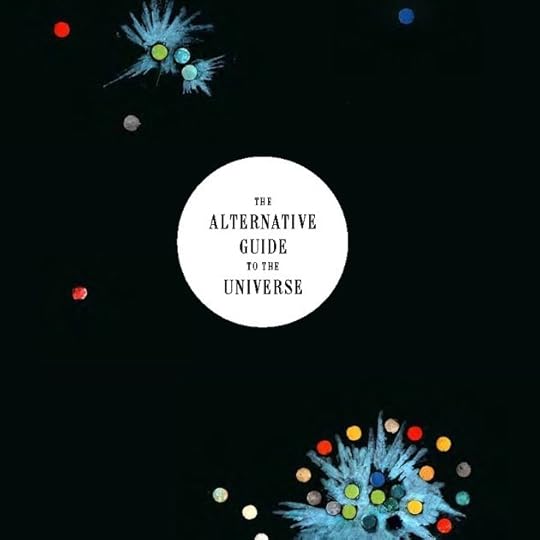
Alternative Guide to the Universe (photo credit: http://www.southbankcentre.co.uk)
A listener posed this question to our tour guide as we stood looking at two art gallery walls covered with self-portraits of a bag lady, taken in various public photo booths.
And this was the question I pondered as I , with my two teenage children, looked round an exhibition of wonders at the Hayward Gallery on London’s South Bank last Saturday.
There, displayed for us in The Alternative Guide to the Universe, were the outpourings of unlicensed architects, off-beam physicists, self-taught artists, arcane code creators, numerologists and mystical theorizers; untrained farmer-inventors of automata and robots, constructors of imaginary buildings and cities from discarded packaging, and proponents of new theories to replace gravity and relativity.
We gazed at elaborate designs for a robot to roam the universe, and crack the mystery of life after death, with a complex scheme for a new language with which this robot would communicate these truths to the future inhabitants of planet earth.
We viewed images of exquisite dolls of children and young people which had been created by one man over 20 years, dressed in clothes he designed and made himself, then posed in numerous positions and photographed; and finally, packed away carefully, not to be seen again by anyone until after his death.
What makes art? I asked myself.
And answers immediately flooded in:
Passion.
Obsession.
Devotion.
Dedication.
A long obedience in the same direction.
The creators of the works we saw were a direct inspiration and encouragement to me as a writer.
Some are long-term residents in psychiatric institutions, others are on the fringes of society, just inside the cusp of (apparent) normality.
And they are all remarkable, exceptional people.
And they all have this in common:
They are focussed, committed, and they direct all their energy into one project consistently, over a number of years which can range from one to three decades.
If you have this kind of commitment you too could in theory create exquisite things.
Your ideas might not ‘work’, but if you are creative in this life, and you leave a body of work behind you that is intriguing and beguiling and fills people with wonder and amazement and awe, you have added something of lasting value to this world. You may even have fulfilled your God-given purpose.
Filed under: Art, art exhibitions, culture, design, dreams and dreaming, empowerment, inspiration, life, London, musings, people of inspiration, places I love, places of inspiration, popular artists, psychology, religion, SC Skillman, SC Skillman Author, spirituality, thoughts Tagged: alternative guide, art, art gallery, awe, commitment, communicate, creators, cusp, design, energy, exquisitive, God, God-given purpose, Hayward Gallery, imaginary, in thi life, life after death, London South Bank, mystery, mystical, normality, obession, passion, robot, the world, truths, universe, wonder, wonders


July 17, 2013
Flowers for John Clare, Poet of Rural England: ‘The Peasant Poet’
This weekend my daughter and I visited family members in Northborough and attended the John Clare Festival in Helpston, Northamptonshire.
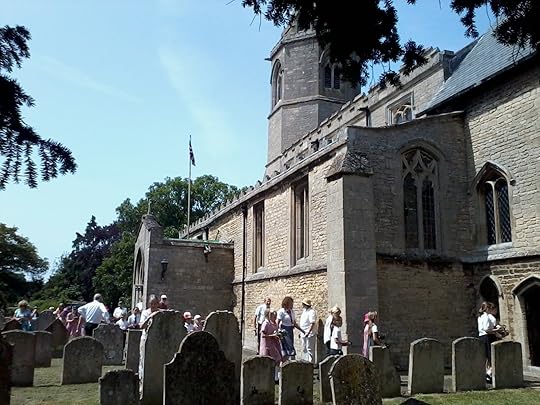
The children of John Clare School bring their flower cushions to lay on the poet’s grave at Helpston Church (photo credit: Abigail Robinson)
We thoroughly enjoyed sharing in the community celebrations of John Clare (1793-1864), their local poet.
JOHN CLARE was born in Helpston in 1793 and deeply loved the natural world. During his life he wrote both poetry and autobiographical prose celebrating rural life and scenery, yet he suffered a series of severe breakdowns in later life, and spent his last 20 years in an asylum in Northampton.
He is now recognized to be as great as his contemporaries Wordsworth, Coleridge, Byron, Keats, Shelley and Blake.
Yet in his time, despite an early ‘false dawn’ when he enjoyed a brief fame and his first volume of poems outsold Wordsworth and Keats, Clare was marketed as ‘the peasant poet’ meaning ‘ill-educated and poor’, hinting that it was remarkable he could write poetry at all, let alone great poetry.
Now in his own community, The John Clare Society ensures he is celebrated, and I highly recommend John Clare Cottage in Helpston. A visit here to learn about the poet, his work and his life is fascinating.
As you enter the Dovehouse in the beautiful cottage garden, you listen to recordings of some Clare poems, recited by adults and by children. Many must be deeply touched by these words of Clare’s:
I am – yet what I am, none cares or knows,
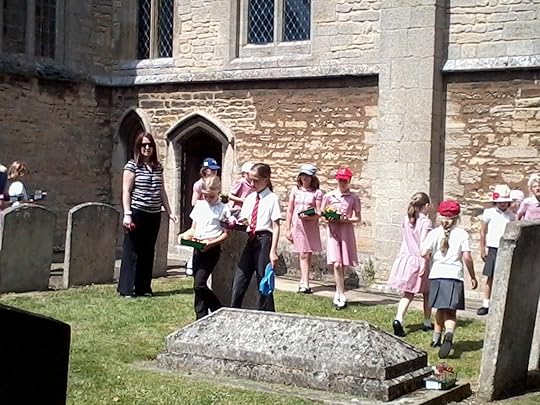
Local schoolchildren bring flowers to John Clare’s grave in Helpston Churchyard (photo credit: Abigail Robinson)
My friends forsake me like a memory lost;
I am the self-consumer of my woes
They rise and vanish in oblivion’s host…
How comforted and reassured John Clare may have been if he could have looked into the future and seen not only his greatness as a poet fully recognized, but also his memory honoured in such a beautiful way today in his own community.
We listened as a choir of children from John Clare School sang to us, and watched as prizes were awarded to the winners of a poetry competition for a poem about the natural world, in the tradition of John Clare.
This event, together with others held during the John Clare Festival in Helpston, made an inspirational weekend; local bards and poets laureate competed in a poetry slapdown with poems that were not only very funny but also thought-provoking.

The children’s flower cushions on John Clare’s grave (photo credit: Abigail Robinson)
And I reflected, that in this life, sometimes people who live by their imagination, in order to inspire others, suffer as John Clare did, with lack of recognition, with social and class prejudice, with mental ill health; often the creative life can bring suffering. Yet creative people ultimately are driven forward by a deep love of their subject; so it was in the case of John Clare.
I for one cannot read his exquisite poetry about flowers,woodlands, open fields, birds, animals and insect, and then observe the very things he wrote about, without feeling this.
Filed under: About Books I love, Authors I love, Books, British, empowerment, English countryside, history, inspiration, life, literature, musings, people of inspiration, places of inspiration, SC Skillman, SC Skillman Author, thoughts, UK, wildlife, Writing Tagged: creative writing, Helpston, imagination, in this life, inspirational, John Clare, John Clare Cottage, John Clare Festival, love, peasant poet, people of inspiration, poetry, SC Skillman author


July 11, 2013
Book Trailer Fun for Mystical Circles
I’ve been out and about in Warwick and the Cotswold hills with my film-maker daughter Abigail, having great fun as Abigail puts together a book trailer for my romantic suspense novel Mystical Circles.
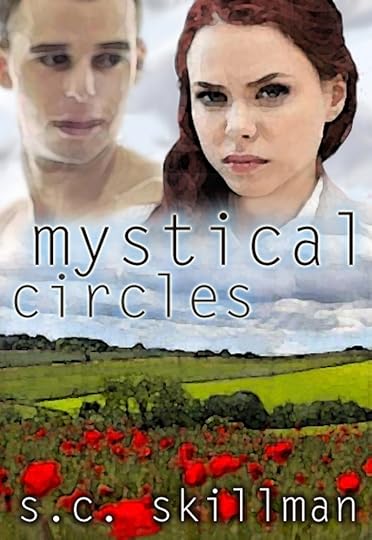
Mystical Circles cover image
As I’ve watched our actors follow Abigail’s directions and play my characters, my story has come alive in a new way. I’ve been reminded of the reason why I wrote the novel in the first place; the events in my own life that provided inspiration.
We’ve been filming in a setting that could be Craig’s sixteenth century farmhouse in that Cotswolds valley – HQ of the New Age spiritual group Wheel of Love. So much so, that when you see it, you’ll believe you are there.
As I watch our actress, I feel what it’s like to be 22-year-old Zoe, who’s not long out of university, and believes she’s found paradise. What more could she want in this life than a vocation, a loving partner, a spiritual philosophy, and on top of that, a beautiful place to live in?
Zoe determines to stay there for ever; and sends an excited email to her sensible older sister Juliet. No sooner has freelance journalist Juliet received the email than she drops everything, jumps into her car in London, and drives up to Gloucestershire to investigate, thus setting the whole story in motion.
This is the perfect time of year to be shooting the book trailer. The story takes place in the month of June.

Cotswolds landscape 6 June 2013 (photo credit: Abigail Robinson)
We’ve just filmed Craig and Zoe together, and we still need to film Juliet and Zoe arguing with each other.
The actors are having fun with this, and so are we!
And I’m delighted with the positive response from so many people involved in our project, some have made locations available to us, others have volunteered their acting skills, and one has even provided a high resolution video camera. It is their good will which is making this book trailer possible.
Here are a couple of shots to whet your appetite for the book trailer.
I hope it will appears on my You Tube channel in the next couple of weeks.
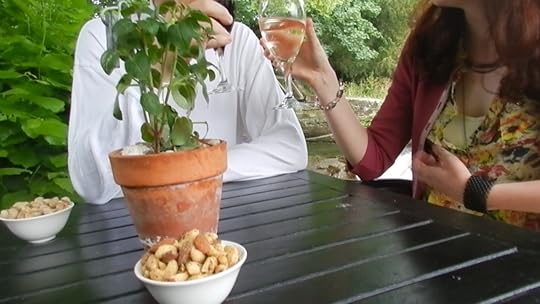
actors playing Zoe & Craig (photo credit: Abigail Robinson)
Watch out for the link to it on this blog!
Filed under: About Books I love, Books, British, British landscape, British romantic suspense writer, creative writing, English countryside, inspiration, interpersonal relationships, life, literature, love, media, Mystical Circles, nature, places I love, places of inspiration, romantic suspense, romantic suspense fiction, SC Skillman, SC Skillman Author, spirituality, Writing Tagged: book trailer, Cotswold hills, English countryside, great fun, in this life, love, loving partner, mystical circles, new age, paradise, romantic suspense fiction, SC Skillman author, spiritual, spiritual group, spiritual philosophy


July 3, 2013
In Search of Authenticity: Our True Selves and Our Essential Need for Community
How can we be true to ourselves?
And how can we live in ways that are true to what we believe?
And how can we mix up our inner and outer worlds, so we are not compartmentalised like a waffle, but rather, more like a bowl of spaghetti?
These were just three of the questions posed to us at a weekend conference I’ve just attended, as one of 80 from my church, St Mark’s in Leamington Spa, at the Hayes Conference Centre in Swanwick, Derbyshire.
our group from St Mark’s in the main conference hall at Hayes Conference Centre Swanwick 29 June 2013 (photo credit: Paul Mileham http://www.st-marks.net)
And in between enjoying the beautiful gardens in the sunshine, drinking in the bar, wandering by the lakes, going kayaking, cycling or walking, we listened to an excellent speaker, Annie Naish from the Lee Abbey Community.
The theme was Authenticity.
Annie invited us to consider how as members of a Christian community we can be “real” with each other, our authentic selves, sharing our sorrows and troubles, recognizing we are all wounded people, and that we all need each other.
To illustrate our need for community, she played a video clip from the BBC TV documentary narrated by David Tennant, showing the solitary Emperor Penguin in the icy wilderness of Antarctica, who became separated from his community, but struggled on alone until he reached them again – and the life-saving comfort of their body warmth.
Annie Naish (photo credit Paul Mileham http://www.st-mark.net)
And just so, said Annie, should we live this out, through our relationships with each other in our community: by showing sincere and practical love; looking for the good in people; putting others first; being willing to be vulnerable; listening; and showing humility and practising forgiveness.
Anybody who ever seeks to understand this life and our place in it, will have to engage with this search for our true authentic selves.
This is the work of a lifetime, and it runs through many religions and faiths, through psychology and philosophy, through psychotherapy, psychoanalysis and counselling.
Annie herself lives as part of the Lee Abbey Community, and every member has to work through their relationship with each other within the community. Churches, said Annie, should be full of wounded people, places where people can weep, and share the tough times they’re going through. The authentic Christian life is “systematically unsafe”. It’s a risky business, and sometimes it’s like a bungee jump over white water rapids. And she showed us a breathtaking video clip to demonstrate this.
Annie suggested we should be intentional. An authentic Christian faith is a long obedience in the same direction.
And if we are to be authentic in relationships, we have to bring what is hidden into the light. It’s costly, because we’re vulnerable.
The young people having fun at Swanwick (photo credit: Jamie Robinson)
Annie gave us practical guidance. We have to listen and reflect before leaping to self-defence. This applies in many situations in life.
Annie called for us to think of everything we do as a task done through relationship.
And the goal for each of us, as Elrond said to Aragorn in “The Lord of the Rings” , is to “Become all that you were born to be.”

the lake at Hayes Conference Centre 29 June 2013 (photo credit: Paul Mileham http://www.st-marks.net)
Filed under: English countryside, faith, inspiration, interpersonal relationships, Jungian psychology, life, love, musings, people of inspiration, places I love, places of inspiration, psychology, religion, SC Skillman, SC Skillman Author, spirituality, thoughts, TV programmes, wildlife Tagged: Annie Naish, authentic selves, authenticity, believe, Christ, Christian, churches, faiths, forgiveness, humility, in this life, inner and outer worlds, Lee Abbey, love, need for community, relationships, religion, risk, SC Skillman, St Marks Leamington Spa, true self, unsafe, vulnerable, weep, what we believe, wounded


June 24, 2013
The Royal Albert Hall, London – A Place of Wonder and Inspiration
The Royal Albert Hall is one of my favourite London venues.
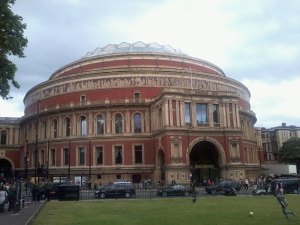
Royal Albert Hall, London (photo credit: Abigail Robinson)
I was there on Saturday, with my daughter Abigail, watching a performance of Swan Lake in the round, by the English National Ballet. Sixty swans danced in the arena below us, transformed into a lake by skilful lighting effects; and the audience delighted in the performances of Dmitri Gruzdyev as Prince Siegfried and Fernanda Oliveira as Odette and Odile.
The earliest memory I have of the Royal Albert Hall is when, as a child, I sang in the Chorus of Younger Angels in a performance of Mahler’s 8th Symphony.
I stood close to the organ; and I’ve never forgotten that tremendous experience as trumpets, drums and organ, under Leonard Bernstein’s flambuoyant direction, brought Mahler’s ‘Symphony of a Thousand’ to its thunderous conclusion.
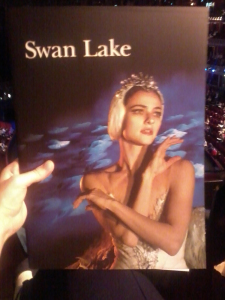
Programme for Swan Lake performance 23 June 2013
During my sixth form days in Orpington, Kent, I often took the train to London with my schoolfriends so we could sit on the pavement outside the Royal Albert Hall in a queue for promenaders tickets for the BBC Proms; and then, once inside the door, sprint to the arena, to find the best place at the front, near the conductor’s rostrum.
One summer, I spent several hours walking up and down the queue with spare tickets to sell, having bought Gallery tickets for a half season.
Later, when I lived in Bayswater, London W2, the Royal Albert Hall was just a stroll across Kensington Gardens, to go to the rehearsals and concerts of another choir I sang in – the London Choral Society.
Whenever I now enter the Royal Albert Hall, I feel a deep sense of affection and euphoria.
This great circular space is to me, and to many even without such memories, both grand and intimate.
It’s also wonderfully flexible,with its central arena, for many great occasions.
The Hall was originally supposed to have been called The Central Hall of Arts and Sciences, but the name was changed by Queen Victoria to Royal Albert Hall of Arts and Sciences when laying the foundation stone, as a dedication to her deceased husband and consort Prince Albert. It forms the practical part of a national memorial to the Prince Consort – the decorative part is the Albert Memorial directly to the north in Kensington Gardens, now separated from the Hall by the road Kensington Gore.
Thank you to Queen Victoria for deciding to commemorate Albert in this, among many other ways!
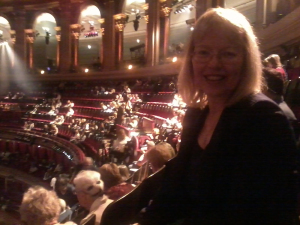
Sheila in the Royal Albert Hall auditorium (photo credit: Abigail Robinson)
Filed under: British, buildings, classical music, empowerment, history, inspiration, life, London, love, musings, places I love, places of inspiration, SC Skillman, thoughts Tagged: choir, choral singing, concert hall, English National Ballet, euphoria, grand, Leonard Bernstein, London, London Proms, love, Mahler, Royal Albert Hall, SC Skillman author, singing, Swan Lake, Victoria and Albert


June 20, 2013
Gazing Out to Sea: The Beauty of the English Coastline
I recently visited Beachy Head, East Sussex, with a friend and my two teenage children.
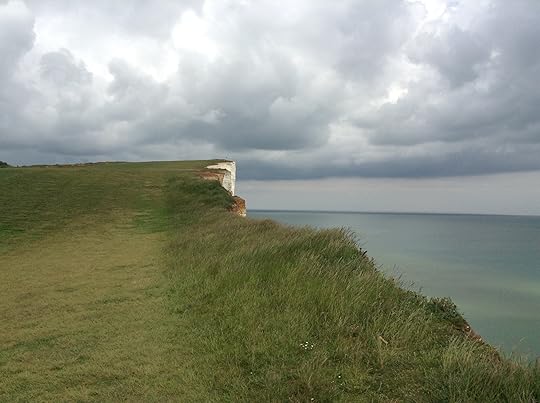
Shining cliff (photo credit: Abigail Robinson)
As we walked along the cliftop, we all agreed: Where in the world could we go that’s more beautiful than this?
Beachy Head, together with the Seven Sisters Country Park and Birling Gap are all protected by The National Trust and they are a short drive out of Eastbourne on the south coast.
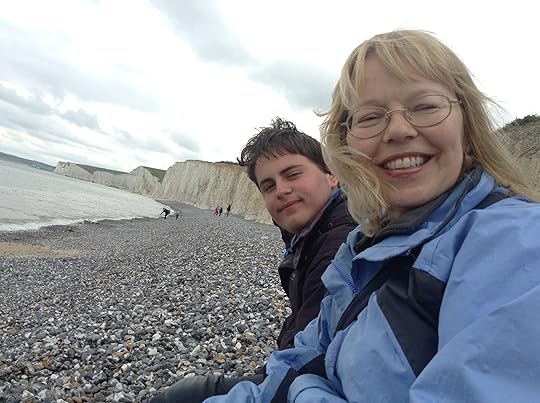
on Birling Gap Beach (photo credit: Abigail Robinson)
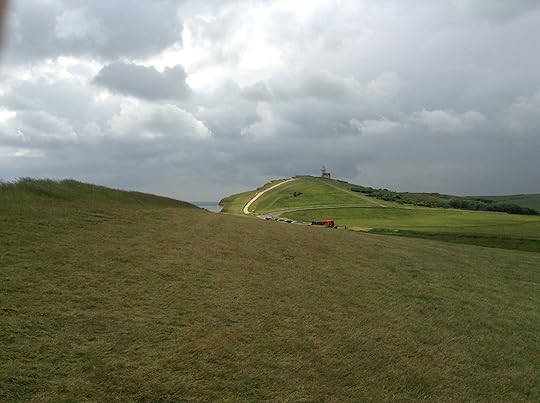
Bright path (photo credit: Abigail Robinson)
I was born and brought up in Kent, and it was only thirty five minutes drive from where we lived to the south coast. Camber Sands was a particular favourite, and we regularly visited and ran over the open dunes, usually going on afterwards to the lovely old fishing town Rye, with its evocative fifteenth century Mermaid Inn.
On every trip, I felt the excitement of that first view of the sea.
And now, I say to my own children, just as my father said to us: ”who’ll be the first to catch a glimpse of the sea?”
Everything depends upon our own inner state, as we contemplate such landscapes, which can then become sacred spaces.

gazing out to sea (photo credit: Abigail Robinson)
For me, standing on a cliff gazing out to sea is a thing of beauty, a joy for ever.
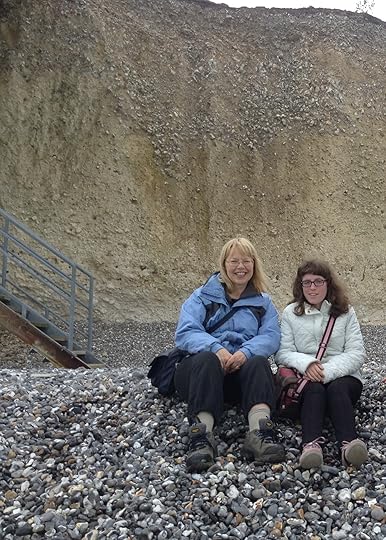
Sheila & Abigail on Birling Gap Beach (photo credit; Jamie Robinson)
Filed under: British, British coastline, British landscape, British mystery romance writer, British romantic suspense writer, English countryside, inspiration, life, musings, nature, places I love, places of inspiration, SC Skillman, SC Skillman Author, spirituality, thoughts, travel, UK Tagged: a thing of beauty, Beachy Head, beauty, Birling Gap, bright path, Camber Sands, coastal scenery, contemplate, English coastline, first view of the sea, fresh possibilities, fresh purpose, gazing out to sea, hope, infinite possibilities, inner state, joy, Mermaid Inn, National Trust, peace, purpose, renewed hope, Rye, sacred spaces, SC Skillman author, scenic beauty, sea, shining cliff, south coast of England


June 9, 2013
A Golden Field, a Short Life That Touched Many Hearts, and a Poignant Moment in a Country Churchyard
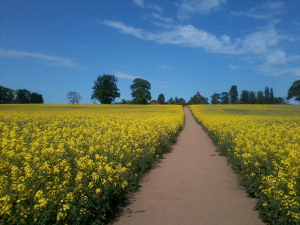
Milverton Hill Fri 7 June 2013 (photo credit: Abigail Robinson)
This photo was taken on Milverton Hill, Leamington Spa between St James’s Church Old Milverton and the Saxon Mill, Warwick.
At about 4.30pm on Friday 7 June I walked with my two teenage children through the churchyard to reach this field.
A late summer afternoon in the English countryside is such a quiet, luminous, poignant time.
And it’s one of the loveliest times to be on Milverton Hill. You breathe in a green woody scent, a fragrance of light and sunshine.
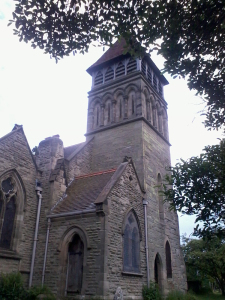
Old Milverton Church 7 June 2013 (photo credit: Abigail Robinson)
As we walked through the churchyard to reach the field, we found a plaque in the grass:
8th June 1995-23rd April 2009
aged 13 years
sweet, rare, exquisite
Ruby’s mother Sarah was tending the flowers, and Ruby’s father Richard was mowing the grass.
Ruby was in my daughter Abigail’s year at school, and Abigail knew Ruby and her story, as many others in our area do, whose hearts were touched by Ruby’s three year struggle with cancer, and her death in 2009.
Sarah, cheerful and pleasant, said to Abigail, “You’re the age Ruby would have been. Tomorrow is her 18th birthday.”
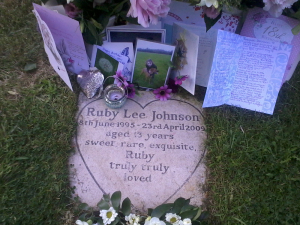
Ruby Johnson 18th birthday memorial (photo credit: Abigail Robinson)
Ruby’s dog Gracie was with them too. Propped against the flower containers by the plaque is a photo which shows this family pet with Ruby 5 years ago.
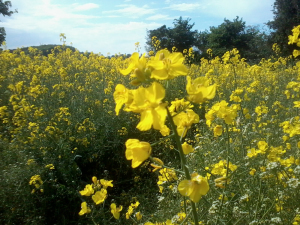
rapeseed & shepherd’s-purse flowers(photo credit: Abigail Robinson)
As we walked out through the gate onto Milverton Hill, beyond the church, I couldn’t help comparing the shortness of Ruby’s life to the transience of golden fields in the English countryside.
In this lovely field, popular with walkers, the cobweb tracery of Shepherd’s-Purse flowers, too, appear between the golden rapeseed flowers. Each petal is silk to the touch, and you feel the cool breeze as you face towards the church. Turning back again to face down towards the Guy’s Cliffe House ruin and the Saxon Mill, the trees seem sculpted against a radiant horizon of intense clarity, each golden flower backlit.
Golden fields don’t last long. But they do reappear each summer. And so will this little memorial to Ruby touch many hearts through future generations.
Filed under: British, English countryside, inspiration, life, musings, places I love, places of inspiration, SC Skillman, SC Skillman Author, spirituality, thoughts, UK, Writing Tagged: cancer, country churchyard, English countryside, Guy's Cliffe House Warwick, Old Milverton Church, poignant moment, Ruby Johnson, Saxon Mill Warwick, short life, summer evening, touched hearts, young death



